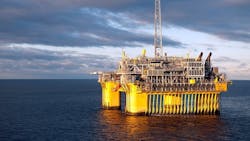Offshore staff
STAVANGER, Norway – Equinor and its partners are considering a switch to power from shore for three platforms in the Norwegian North Sea currently powered by gas turbines.
The transition, the company claims, could reduce carbon-dioxide (CO2) emissions from Troll C and the Sleipner field center area, including the Gudrun tie-in platform, by more than 600,000 metric tons/yr (661,387 tons/yr).
This would involve using and expanding existing infrastructure from land, said the company’s NCS executive vice president Arne Sigve Nylund.
On Troll C, the estimated CO2 emission reduction potential through electrification is 365,000 metric tons (402,344 tons) annually, while electrification at Sleipner and Gudrun (the latter is currently powered from Sleipner) could cut emissions here by 250,000 metric tons/yr (275,578 tons), with associated reductions in nitrogen oxide (NOx) emissions of around 2,500 metric tons (2,756 tons) for all three installations.
“Adding this to reductions that will be achieved by choosing land-based power supply toJohan Sverdrup, Gina Krog and Martin Linge, we see the potential for cutting more than 1.3 MM metric tons of CO2 in total per year,” Nylund said, equivalent to annual emissions from more than 650,000 private cars.
Equinor chose the three platforms as the best candidates from a study of its operated fields on the Norwegian shelf.
“Powering major offshore oil and gas installations from land is no easy task,” Nylund cautioned. “There are many challenges, both technical and financial, and several of our installations are in areas with no possibility for tying in to land-based power supply.
“The reason why we are looking at the potential for land-based power to Troll C and the Sleipner area is that they can utilize existing power supply infrastructure, they have large remaining resources and the measures will lead to considerable CO2 reductions.”
At theTroll field the Troll A gas platform has been powered from shore since start-up in 1996, and is operated with minimal production emissions, Equinor claimed. It aims to link Troll C to the same power solution via a power cable from the Kollsnes plant close to Bergen.
The Johan Sverdrup field will be powered from land, along with other developed fields on the Utsira High, including Equinor’s Gina Krog, which came onstream last year. The company is considering extending the power supply from Gina Krog to connect the shore link to the Sleipner field center and theGudrun platform.
Last year Equinor attained its goal ofreducing its annual CO2 emissions from the NCS by 1.2 MM metric tons (1.32 MM tons) from 2008-2020, and it is now seeking further cuts of 2 MM metric tons/yr (2.2 MM tons) by 2030 from its offshore operations.
06/12/208



